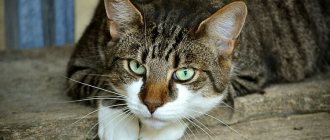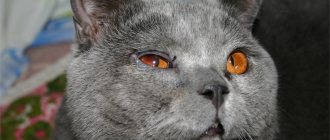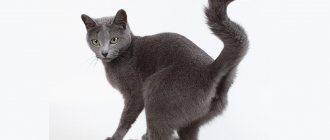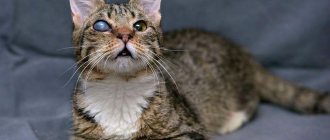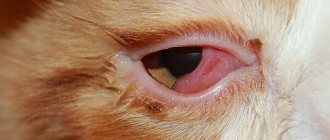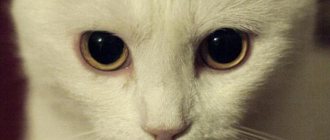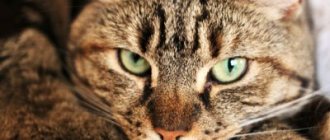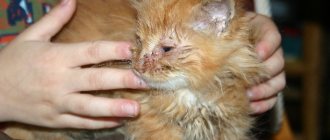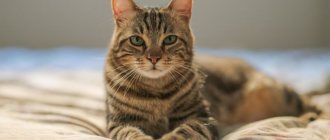For normal functioning of the organs of vision, the anterior surface of the eyeball of mammals must always be well moistened. This task is performed by the lacrimal apparatus. A cat's lacrimal glands constantly secrete a small amount of tear fluid, which has a protective and disinfectant function. The waste moisture goes into the so-called lacrimal lake, which communicates with anatomical structures - lacrimal openings. These are small holes in the corners of the eyes that lead into the tear ducts. Through them, moisture flows into the nasal cavity and evaporates under the influence of breathing.
If the animal is healthy, then there is practically no excess tear fluid. There is no discharge from the cat's eyes at all. A small amount of transparent liquid secretion may be released, which is practically invisible from the outside and does not require elimination.
If the discharge is copious, opaque, has an unpleasant odor and color, it can be assumed that there is an eye pathology. White, green, reddish, brown discharge indicates a bacterial or fungal infection. Let's look at why this happens, let's look at the main causes of pathological discharge from the eyes, find out how to treat the animal, what first aid measures are.
Normal eye discharge
In most cases, cats have slightly wet, shiny eyes. The lacrimal glands secrete secretions to moisturize the mucous membranes. This helps clean the outside, prevents drying out and provides some protection from damage. Cats' eyes do not normally run, but they may release a small amount of fluid when they encounter irritants. Bright light, dust, wind or cigarette smoke can act as a provocateur.
Periodic lacrimation is observed in brachycephalics. In cats with flattened faces, the functioning of the glands and the outflow of fluid are disrupted after a long stay in a horizontal position or on the side. Animals with large bulging eyes are more susceptible to infectious inflammation and external factors, since their organs are less protected by skin folds. The risk group includes Persian and Scottish cats, exotics, bobtails, etc. Representatives of these breeds and mestizos, which have inherited specific traits, require careful care and removal of discharge.
Cosmetic defect
Brown discharge from the corners of the eyes in cats is not always a sign of pathology. The cornea is constantly washed by tear fluid, but under certain circumstances it becomes larger.
The amount of discharge increases in strong winds, due to bright light, if the cat is in a dusty or smoky room.
The tear fluid contains substances that, when exposed to ultraviolet radiation, acquire a brownish tint. Dark discharge is most noticeable in the following cats:
- with light coat color;
- with a flattened muzzle;
- in older individuals;
- in emotional pets - when they purr, they produce copious amounts of tears or saliva.
Minor discharge, which over time turns into dried brown crusts, is not a pathology and does not threaten the cat in any way. This is just a cosmetic defect. Brown marks are usually removed using daily hygiene products.
Attention! You should not wipe your cat's eyes with hydrogen peroxide. If it comes into contact with the mucous membrane, the solution may cause irritation and discomfort.
The main types of pathological discharge from the eyes
Excessive tearing is not normal, even if the liquid is clear. In case of diseases and injuries in pets, the following main types of pathological discharges can be detected:
- Transparent liquid of normal consistency. A sign of involuntary lacrimation. May occur as a result of injury or in the early stages of disease. Transparent color and liquid consistency indicate the absence of infection. With insufficient hygiene, tears can oxidize and turn into brown crusts, but initially there is no bright shade.
- White mucous discharge. Occurs at the initial stage of inflammation. At this time, it is most often possible to quickly suppress the disease with timely and adequate treatment.
- Greenish or yellow thick discharge. Appear in the last stages of infectious infection. The color indicates the presence of pus. Most often, such discharge is accompanied by general weakness, fever and a state of intoxication. Without help, the animal may lose an eye. Possible death.
- Thick brown or black discharge from your cat's eyes. The hue indicates the presence of red blood cells in the liquid. An increased concentration of red blood cells may be associated with a violation of the anatomical position of the ducts or improper outflow of fluid. Sometimes brown discharge appears in the later stages of infectious diseases if pathogens have penetrated the choroid.
Brown discharge may occur in brachycephalic breeds and breeds with protruding eyes. Conventionally, this sign is sometimes considered normal, but it is advisable to visit a veterinarian for analysis and identification of pathogenic microflora.
DISCHARGE FROM THE EYES IN CATS // Network of Veterinary Clinics BIO-VET
What do the symptoms mean?
The color of the discharge and some other symptoms can indicate the possible factors behind the cat’s painful condition.
- Purulent secretion (sometimes mixed with red or brown pigment) indicates a bacterial infection. In this case, the cat may become lethargic; when palpated, its nose is hot and dry.
- Translucent, thick or thick and runny discharge indicates a viral infection. Usually, with a viral infection of the eyes, no pus is observed.
- If a cat's eyes run brown, it is most likely epiphora from the first group described above. That is, the reason is not an infection, but a disruption of the tear ducts.
- Normal tears, but discharged in large quantities, are due to allergies. In this case, swelling and redness of the eyelids may occur.
- Red secret. Usually this is the same brown discharge, but it appears red in white and very light-colored cats. On dark fur there is a brown tint.
In rare cases, dark discharge from the eyes of cats is provoked by nutrition. If, along with vision problems, there is diarrhea, vomiting or constipation, change your pet’s diet.
Causes
The appearance of dark discharge and brown crusts around a cat's eyes may be due to a violation of the outflow of fluid through the tear ducts or infectious diseases.
Impaired outflow of tear fluid through the nasolacrimal duct (dacryocystitis)
The development of the disease can occur for several reasons:
- Inflammatory processes. Due to diseases of the eyes and neighboring tissues, swelling occurs. This leads to narrowing of the tear ducts and difficulty in fluid circulation.
- Stenosis of lacrimal openings. Narrowing most often occurs as a result of chronic infectious lesions. Stenosis is accompanied by constant lacrimation.
- Blockage by a foreign body. Small debris can get into the ducts and cause inflammation. Later, infection may occur.
- Mechanical injury. If the canals are damaged, black or brown discharge from the eyes of cats is observed. The color is due to the presence of bloody impurities.
- Neoplasms in the lacrimal glands or adjacent tissues. Tumors cause mechanical narrowing of the ducts. With the simultaneous destruction of tissue, blood appears in the secretions. The color turns red or brown.
Infectious inflammation of various areas of the eye structures
There are several forms of infectious lesions of the organs of vision:
- Blepharitis. Inflammation of eyelash bulbs. The owner may think that the cat has dirt in its eyes. Discharge accumulates in the corners. They may be grayish or brown in color.
- Conjunctivitis. Damage to the mucous membrane, which is accompanied by swelling of the eyelids, redness and the appearance of purulent discharge. In later stages, cats are unable to open their eyes due to crusts.
- Keratitis. Corneal damage. Most often, the disease develops due to mechanical trauma and infection. Pathology is accompanied by the formation of a pathological infiltrate. When deep vessels are affected, the discharge becomes dark in color.
- Iridocyclitis. Inflammation of the choroid. Photophobia is observed in animals. Cats may wash or rub their eyes thoroughly due to pain. First, profuse lacrimation occurs, and later a pathological infiltrate is released.
Diseases and pathologies that cause disturbances in the outflow of tears from the eyes through the lacrimal ducts
This group includes:
- Narrowing of the tear ducts of an inflammatory nature.
- Stenosis of the lacrimal openings (too small tubules).
- A foreign object that has entered the lumen of the lacrimal canal.
- Eye injury, as a result of which the functioning of the lacrimal system was disrupted.
- Dacryocystitis (non-infectious inflammation of the lacrimal sac).
- Allergy.
- Tumors, neoplasms, compressing tubules.
© shutterstock
Treatment of the disease
If you have a question about how to treat your cat, you need to contact the clinic. The doctor will examine and interview the animal owner. Fluid may be collected from the tear glands for testing. This allows you to identify the strain of bacteria and select an effective drug. Depending on the causes of the disease, anti-inflammatory drugs and antibiotics can be used. In advanced cases, surgery is performed. Surgery may involve removing the eye, widening the tear ducts, removing a foreign object, etc.
If visiting a veterinarian is not possible, you can administer first aid to improve the condition yourself. It is recommended to use chamomile decoction for rinsing. It is prepared from pharmaceutical raw materials and distilled water. It is important to use clean liquid, otherwise the eye may become infected.
For rinsing you will need a cotton pad. It is recommended not to use gauze or standard cotton wool, as particles may remain on the surface. Rough fabric can damage delicate mucous membranes. A cotton pad is moistened in the liquid and gently wiped from the inner corner to the outer corner. If there are crusts, do not roughly remove them. You should soak the accumulations, then try to carefully remove them.
Both eyes need to be treated. A separate swab is used for each to prevent transmission of infection. It is allowed to use antibacterial solutions for treatment after permission from a veterinarian.
Diagnostics
If the owner notices brown discharge around the cat's eyes, he needs to take the pet to a veterinary clinic. In most cases, examination and history is sufficient to make a diagnosis.
Sometimes it is necessary to conduct additional tests to help rule out head and eye injuries, as well as diseases of internal organs and infectious diseases. To do this you may need to do:
- Ultrasound of the organs of vision;
- X-ray of the skull;
- blood and stool tests.
Prevention
Prevention consists of monitoring and caring for your pet. Most breeds do not require intervention, however, in the case of cats with flattened faces, it is necessary to remove the discharge when it appears. The natural secretion, when dried and oxidized, forms a good environment for the growth of bacteria. This increases the risk of developing diseases.
Eye diseases in kittens! Herpes of the eye and calicivirus in cats.
To prevent discharge, it is recommended not to give your cat sweets. Animals metabolize sugar worse than humans. Some of the breakdown products enter the bloodstream and cause a reaction from the immune system. This causes discharge from the eyes, itching and redness of the skin.
All information posted on the site is provided in accordance with the User Agreement and is not a direct instruction to action. We strongly recommend that before using any product, you must obtain a face-to-face consultation at an accredited veterinary clinic.
Prevention of eye diseases in cats
Prevention of eye diseases consists of the following actions:
- do not smoke in the room where the pet lives, avoid using perfumes and household chemicals;
- use hypoallergenic ready-made comas of at least premium class;
- destroy ectoparasites and conduct quarterly deworming;
- Vaccinate your pet regularly according to the vaccination plan.
- cats predisposed to eye diseases are periodically instilled with prophylactic agents.
Be sure to read:
The cat does not drink water: reasons, daily intake, what to do, is it dangerous, how to force the animal to drink
Eye diseases or digestive disorders are caused by human food, so giving your pet a treat can result in illness.
Treatment and prevention
Depending on the cause of inflammation, the veterinarian develops a treatment regimen for the cat:
- In some cases, local therapy using drops or ointments with antimicrobial, analgesic and anti-inflammatory effects is sufficient.
- If brown discharge appears due to congenital pathology of the eyelids, surgery is recommended.
- Surgery cannot be avoided when a cat has an eye tumor.
- If the tear ducts are clogged or blocked, rinsing helps, but if they are narrowed, surgery may be necessary.
- If a kitten is diagnosed with an infectious disease, one of the symptoms of which is purulent eyes with brown discharge, then the pet is treated not only with eye drops, but with antiviral drugs and immunostimulants.
- For helminthiasis, which is accompanied by tearing, antiparasitic drugs are used.
Types of eye drops for cats
In most cases, treatment for brown discharge involves the use of topical eye medications. These include drops and ointments. They are divided into 3 groups - antimicrobial, antibacterial and antiviral (immunomodulatory).
Antiseptic drops
Antiseptics can be used for the prevention and treatment of ophthalmic diseases:
- Ophthalmosan. A preparation based on chlorhexidine and succinic acid. These components inhibit the development of pathogenic microflora. For brown discharge in cats, use 2-3 times a day, 2 drops under the lower eyelid. The duration of the course of treatment is determined by the veterinarian.
- Lacrican. The main component is the antiseptic polysept, which prevents the proliferation of microbes. The drug also contains anesthesin, a substance with an analgesic effect. After preliminary cleaning of brown discharge, 2 drops of medicine are injected under the cat’s lower eyelid. The procedure is carried out 2 or 3 times a day for 8–10 days.
Antibacterial drops
These are drugs that destroy gram-positive and gram-negative bacteria - chlamydia, mycoplasma, staphylococcus, Pseudomonas aeruginosa, etc. These microorganisms cause inflammation of the organs of vision, which is accompanied by purulent and brown discharge. List of medications for cats:
- Tsiprovet. It is prescribed for acute or chronic conjunctivitis, keratitis, blepharitis, and corneal ulcers. The active ingredient is ciprofloxacin. Directions for use and dosage for cats: 1 drop in each eye 4 times a day; the course of treatment for brown discharge is 1–2 weeks (until complete recovery).
- Dekta-2. The active ingredient here is gentamicin. It has a wide spectrum of antibacterial action. The medicine also contains dexamethasone, a glucocorticosteroid. This is an anti-inflammatory component. Directions for use: 2-3 drops into the conjunctival sac of the eye 2-3 times a day. The course of treatment is from 5 to 10 days.
- Lakrimin aseptic. Broad-spectrum eye drops based on chloramphenicol and sodium sulfosalicylate. The drug is used for eye diseases with purulent discharge, as well as for postoperative complications and wounds of the eyelids or cornea. Directions for use: 2-3 drops 2-3 times a day for 5-7 days.
Immunomodulatory
This group includes cat drops, which are indicated for use in eye diseases caused by viral infections:
- Anandin. The drops have an immunomodulatory, anti-inflammatory and regenerating effect. For brown or purulent discharge under the cat's eyelid, administer 2 drops of medication in the morning and evening. The course of treatment is from 5 to 7 days.
- Maxidin. The drug is based on an organic compound of germanium, which has high antiviral activity, and also has an anti-inflammatory and regenerating effect. Drops are used to treat conjunctivitis and keratitis of an infectious and allergic nature. Directions for use: 1 or 2 drops under each eyelid 2 times a day until the symptoms of the disease disappear.
How to rinse and apply eye drops at home
Before using medicinal products, it is necessary to clean the cat's eyelids of brown discharge. To carry out the procedure, you will need the help of another person, because the cat will struggle. It is necessary to prepare in advance clean cotton pads (5-6 pieces for each eye), as well as a means for hygienic treatment:
- strained chamomile decoction;
- furatsilin solution – 1 tablet per glass of water;
- weak solution of boric acid.
If none of the above is at hand, you can rinse your eyes with warm boiled water. A cotton pad is generously moistened and gently wiped over the cat's eyelids in the direction from the outer corner of the eye to the inner.
Dirty sponges are put aside - you need to take a clean one every time. It is important to remove all brown discharge and crusts. Only after this the eyes are instilled with a medicinal composition.
Attention! The eyelid cleaning procedure is carried out before each use of eye drops.
Eye diseases accompanied by exudate
In general, in veterinary ophthalmology there are enough eye pathologies accompanied by the appearance of abundant discharge from the conjunctival cavity:
- Keratoconjunctivitis. This is a combination of inflammation of the conjunctival cavity and cornea. In advanced cases, it can lead to blindness.
- Blepharitis. This is what inflammation of the eyelids is called.
- Keratitis. This is a “pure” inflammation of the cornea.
- Uveitis. This is the name for inflammation of the border, the base of the eyeball.
- Iridocyclitis. This is an inflammation of the blood vessels that supply the eyeball.
Most of these diseases are very dangerous and, if left untreated, can lead to complete blindness of the animal.
Treatment methods
The choice of treatment depends on the cause of the disease. The doctor may recommend creams, ointments with an antibacterial effect, antiseptics, and medications with hormones.
Main methods of treatment:
- Antibacterial therapy is carried out in the presence of infectious diseases of the eyes of cats. The medicine is administered by injection. Broad-spectrum drugs are used.
- Eye rinsing is carried out using antiseptics. In the first days, the procedure is carried out in a clinic setting. If the pet's condition improves, it is allowed to treat it at home.
- Pathologies of the development of the eyelids, eyeball, ciliary bulbs, tumors are operated on. Afterwards, a course of antibacterial or chemotherapy is prescribed.
Treatment begins as soon as possible after the appearance of alarming symptoms.
